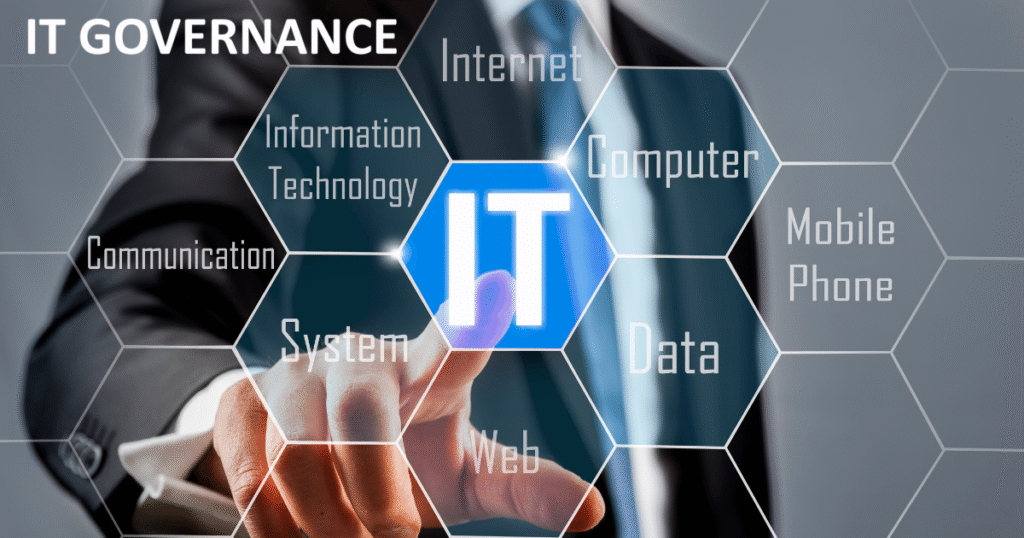
Status: Final Blueprint
Author: Shahab Al Yamin Chawdhury
Organization: Principal Architect & Consultant Group
Research Date: February 21, 2025
Location: Dhaka, Bangladesh
Version: 1.0
1.0 Strategic Imperative and Governance Landscape
Information Technology (IT) has evolved from a support function into a primary driver of business value and competitive advantage. Effective governance is essential to ensure that IT strategy is aligned with business objectives, resources are optimized, and risks are managed. The ISO 38500 standard provides a board-level framework to achieve this by repositioning IT as a core enterprise asset.
A critical distinction is made between Governance (the board’s role to Evaluate, Direct, and Monitor) and Management (the executive’s role to plan, build, and run IT operations). This separation ensures accountability and strategic oversight.
1.1 The Six Foundational Principles of ISO 38500
The standard is built on six high-level, business-oriented principles that guide the governing body’s decision-making:
- Responsibility: Clearly define and accept responsibilities for the supply of and demand for IT.
- Strategy: Ensure the business strategy considers IT capabilities, and the IT strategy supports business needs.
- Acquisition: Justify IT investments with a clear, transparent, and accountable business case.
- Performance: Ensure IT is fit for purpose, delivering reliable and efficient services to meet business requirements.
- Conformance: Comply with all mandatory legislation, regulations, and internal policies.
- Human Behavior: Respect human factors and the needs of all people involved in IT-related processes.
1.2 The Governance Model: Evaluate, Direct, Monitor (EDM)
ISO 38500 provides a simple, continuous cycle for the governing body to execute its duties:
- Evaluate: Continuously assess the strategic landscape, current IT use, and future opportunities.
- Direct: Provide clear strategic direction to management through policies and investment decisions.
- Monitor: Oversee management’s performance against the set direction using KPIs and reports.
1.3 The Integrated Governance Ecosystem
ISO 38500 does not operate in isolation. It serves as the high-level governance “roof” that directs other detailed management frameworks.
- ISO 38500 (The “Why”): Sets the strategic direction from the board.
- COBIT (The “What”): Provides a comprehensive framework for management to execute the board’s direction through detailed processes and controls.
- ITIL (The “How”): Delivers best practices for the operational execution of IT service management, providing the performance data needed for monitoring.
2.0 The Implementation Blueprint: A Phased Approach
Implementing ISO 38500 requires a structured, multi-phase approach to ensure a solid foundation, thoughtful design, and successful enterprise integration.
Phase 1: Program Initiation and Strategic Alignment
This phase establishes the strategic foundation and secures the necessary authority for the governance program.
- Key Activities:
- Establish a formal IT Governance Committee with a board-approved charter.
- Secure an Executive Mandate and stakeholder buy-in with a compelling business case.
- Conduct a Current State Analysis (Gap Analysis) to understand existing processes and weaknesses.
- Perform an IT Governance Maturity Assessment using a model like CMM to baseline capabilities.
- Develop a Strategic Implementation Roadmap with prioritized initiatives and a clear timeline.
Phase 2: Design of the IT Governance Operating Model
This phase translates high-level principles into the specific structures, policies, and processes for daily operations.
- Key Activities:
- Design the Governance Structure, including committees (e.g., IT Steering Committee, Architecture Review Board) and their charters.
- Develop an enterprise RACI Matrix to clarify roles (Responsible, Accountable, Consulted, Informed) for key governance processes.
- Create Core Governance Policies such as IT Risk Management, IT Investment, and Information Security policies.
Phase 3: Execution and Enterprise Integration
This phase focuses on deploying the new model, managing cultural change, and embedding governance into the organization.
- Key Activities:
- Launch an Organizational Change Management (OCM) program with clear communication and training plans.
- Integrate Governance into key lifecycles like Project Portfolio Management (PPM) and the Software Development Lifecycle (SDLC).
- Select and implement a Governance, Risk, and Compliance (GRC) Platform to automate and monitor processes.
3.0 Performance, Risk, and Value Realization
The ultimate goal of governance is to ensure IT delivers value, performance is optimized, and risks are managed.
- Performance Management:
- Establish a balanced IT Governance KPI Framework with metrics for strategic alignment, value delivery, risk, and conformance.
- Develop Performance Dashboards to provide the governing body with clear, actionable insights for monitoring.
- Integrated Risk Management:
- Establish a formal IT Risk Management Framework based on standards like ISO 31000 or NIST.
- Implement a Control Assurance Program to regularly test the effectiveness of key controls.
- Financial Governance & Value Management:
- Mandate a standardized framework for Total Cost of Ownership (TCO) and Return on Investment (ROI) analysis for all major IT investments.
- Establish a Benefits Realization Management process to track and report on the actual value delivered by IT projects.
Chat for Professional Consultancy Services
